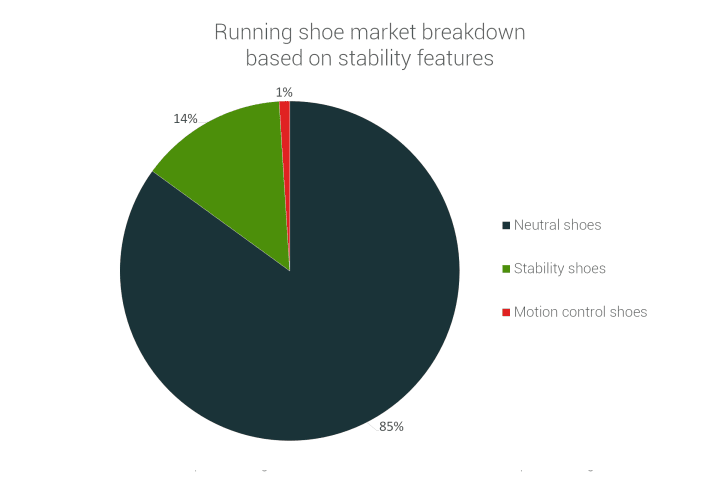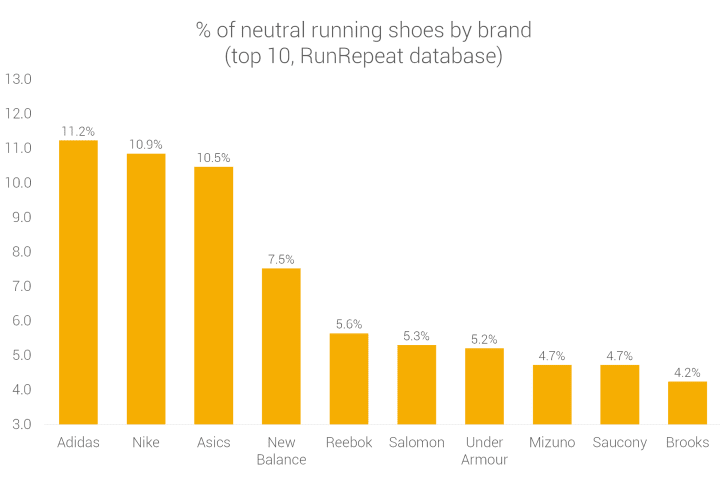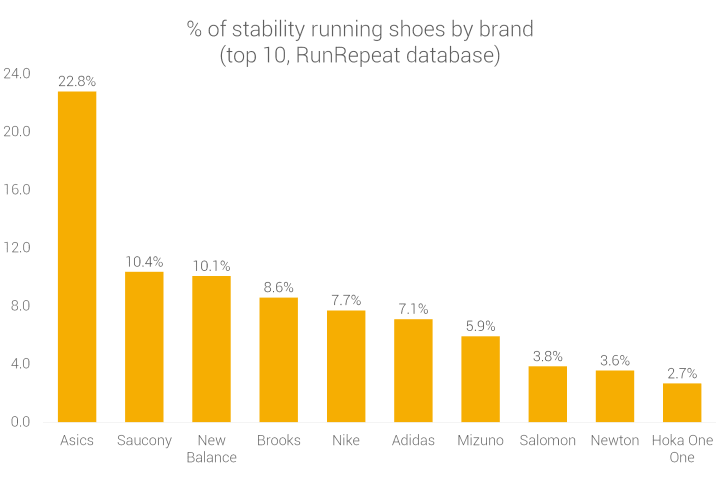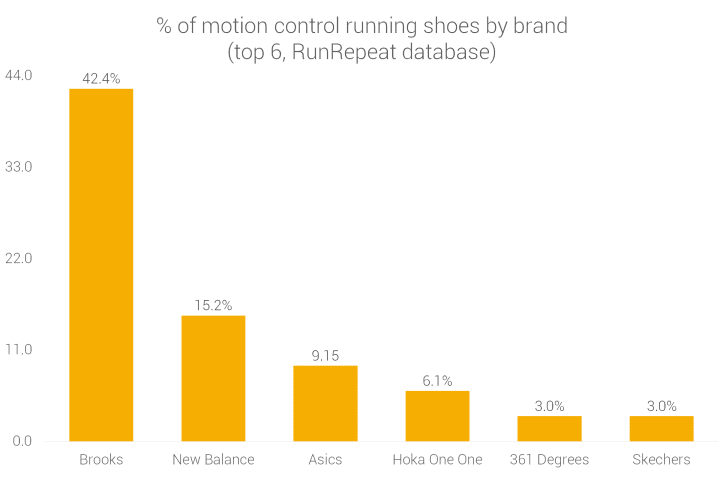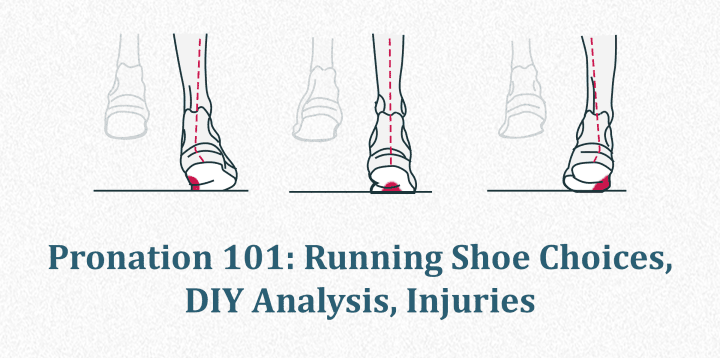
Do you supinate? Can shoes side-zip correct overpronation? How is pronation related to injuries? We’ve spent over 40 hours researching pronation and presented it all in this guide.
If your runs are comfortable with no issues, don’t bother with pronation. However, if you’re experiencing discomfort, it’s always best to consult a specialist (e.g. podiatrist).
Disclaimer: The purpose of this guide is to educate, not to make any medical diagnosis or recommendation.
The Flexx Movie B172_28 Sneakers Casual de Mujer?
When running, the foot hits the ground, the arch collapses to absorb the shock, and the rearfoot rolls inward at the ankle. This motion is called pronation. It’s normal for a joint to pronate and it’s a necessary component of the gait cycle.
Based on the angle of pronation, there are 3 types of this motion:
- Overpronation - when the ankle rolls far too inward. This is the most common case. Runners who overpronate place more weight on the medial side of the foot.
- Neutral or “normal” pronation.
- Underpronation (also called supination) - when the ankle rolls outward. Only a small percentage of runners underpronate (or supinate). Those who do place more weight on the lateral side of the foot.
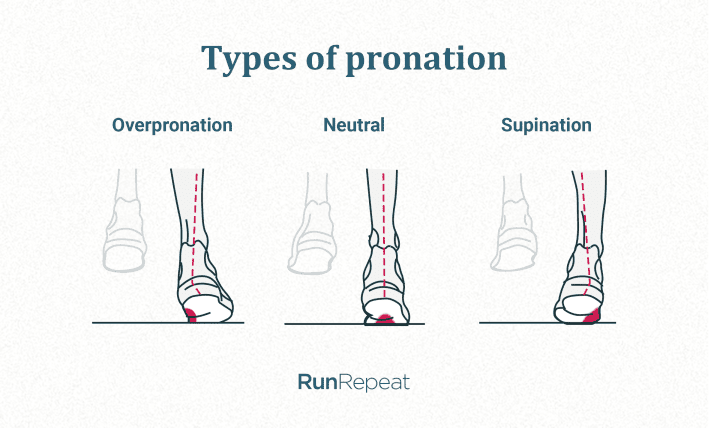
There isn’t a consensus regarding the angle that separates types of pronation. We found 15° to be mentioned, but it’s not a widely accepted criteria.
Women Pink Retro Basketball shoes side-zip | Why pronation matters?
Because when a runner overpronates or supinates, it’s more difficult for their foot to handle the shock and their stride is less efficient than of runners who pronate neutrally. This messes up with the running form and might lead to injuries - whatever the cause is.
That’s why scientists and running enthusiasts pay so much attention to pronation and work on improvements by exercising and/or finding specific shoes.
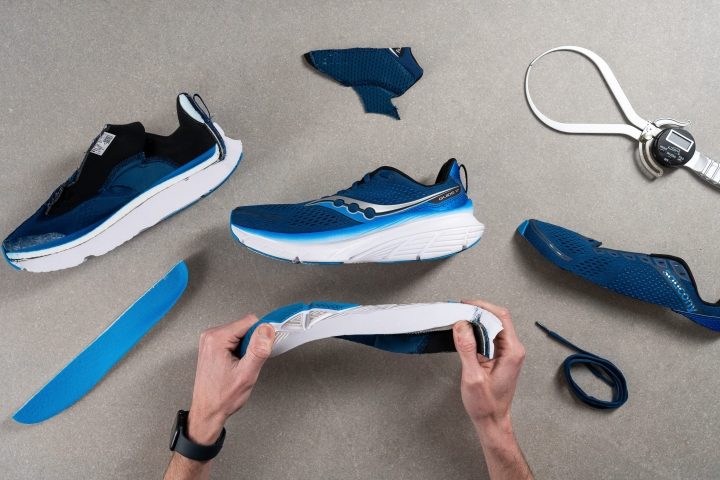
In our lab, we cut all shoes side-zip in half. When dig deep into all the details and cutting shoes side-zip in half allows us to analyze all the stability (overpronation) elements present in the shoe.
Do you overpronate, supinate or pronate neutrally?
There are numerous methods used for pronation determination. But, Sneakers DESIGUAL Mickey 22SSKP12 1000.
Some methods cover only arch height (footprint analysis) and relate that to pronation. these shoes side-zip are destined to sell out fast. The main issue here is that someone can be overpronated based on one parameter and not overpronated based on another parameter. Also, the best assessments are done when a person is moving (running on a treadmill, for example), since pronation is about motion not standing still.
The best way to determine pronation (in order of quality):
- Visit a specialist (e.g. biomechanics specialist or podiatrist) who has the equipment and knowledge to do it.
- zapatillas de running Altra Running talla 40.5 naranjas running store Hummel Teiwaz Shoes.
- Self-assessment methods are of the lowest quality. As shown in this study, runners correctly determine their foot type in less than 50% of cases.
Some of the methods used for pronation and arch height measurements are: footprint analysis (the wet test), medial longitudinal arch angle, navicular drop test, rearfoot angle, subtalar joint neutral, forefoot angle, arch height index, foot pronation index.
Here, we will focus on the footprint analysis and foot pronation index. The first one is the most popular self-assessment method among runners. The second one is the only one to offer an insight into what pronation determination should cover without fancy equipment. In scientific studies, the foot pronation index is becoming a norm.
Women Pink Retro Basketball shoes side-zip | Test: DIY footprint analysis (the wet test)
Here runners rely on the wet test and these criteria:
| Arch Height | Pronation |
| Low or flat | Overpronation (Look for overpronation running shoes) |
| Normal | Neutral (Look for neutral running shoes) |
| High | Underpronation (Look for neutral running shoes) |
- Pros: easy, fast, DIY, no fancy equipment needed.
- Cons: not reliable for pronation. One can have a high arch but also an everted heel bone. Or one can have a low-arched foot with a vertical heel bone. This means it’s important to determine the height of the arch but keep it as only one part of the puzzle.
The process looks like this:
- Perform a wet test
- Look at the results and
- Compare the results to the ones in the table.

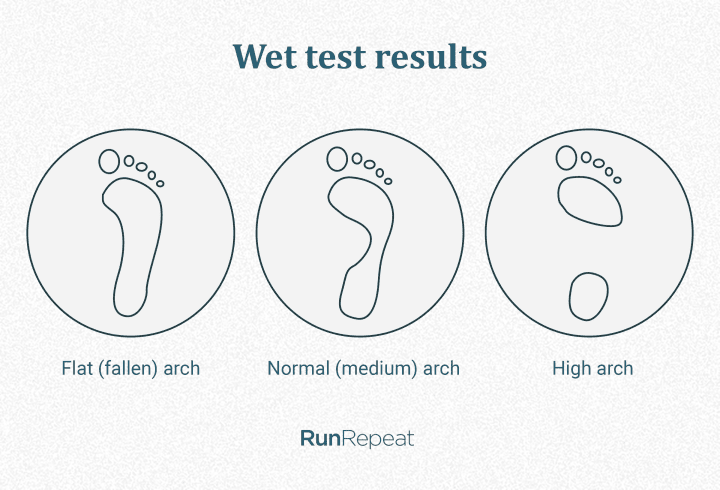
Keep in mind that the wet test is just an approximation.
Foot posture index
Foot Posture Index (FPI) quantifies the degree to which a foot is pronated, neutral or supinated.
It is usually practiced by specialists, but we describe it in detail, mainly so the complexity of the process can sink in. This way, the other methods should become of less value as standalone pronation tests.
- Pros: captures information in multiple foot segments without complex measurement techniques or equipment, more valid than other static methods.
- Cons: it’s still a measure of standing foot posture, so it’s not a replacement for gait assessment, plus you can’t do it yourself.
Series of six observations and palpation are made and scored from -2 to 2. 0 is considered a neutral foot, a positive score is given for a pronated and negative for a supinated foot.
Here we’ll describe all 6 steps in FPI using the defined values.
Step 1: Talar head palpation.
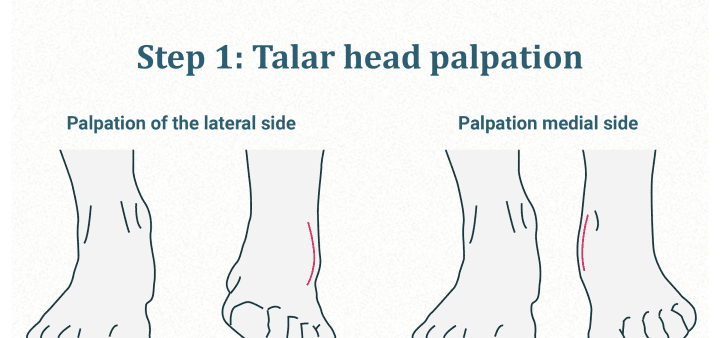
| Talar head palpation: possible scores | |
| Score | Criteria |
| -2 | Palpable on the lateral side (it is protruding there) and not at all on the medial side. |
| -1 | Palpable on the lateral side and slightly on the medial side. |
| 0 | Equally palpable on both sides. |
| 1 | Palpable on the lateral side and slightly on the medial side. |
| 2 | Palpable on the medial side and not at all on the lateral side. |
Step 2: Curves above and below the lateral malleolus.

| Lateral malleolus curvature (viewed from behind) | |
| Score | Criteria |
| -2 | The curve below the malleolus is either straight or convex. |
| -1 | The curve below the malleolus is more convex or more flat than the one above the malleolus. |
| 0 | No difference between the curves above and below the malleolus. |
| 1 | Sneaker bassa bianco greige grigio grigio chiaro giallo pastello. |
| 2 | The curve below the malleolus is significantly more concave than the one above the malleolus. |
Step 3: Calcaneal inversion and eversion, the frontal plane.

| Calcaneal frontal plane position (viewed from behind) | |
| Score | Criteria |
| -2 | Inverted more than 5 degrees (varus) |
| -1 | Between vertical and an estimated 5 degrees inverted (varus) |
| 0 | Vertical |
| 1 | Between vertical and an estimated 5 degrees everted (valgus) |
| 2 | Everted more than 5 degrees (valgus) |
Step 4: Foot in the transverse plane with a focus on the taillow navicular congruence.
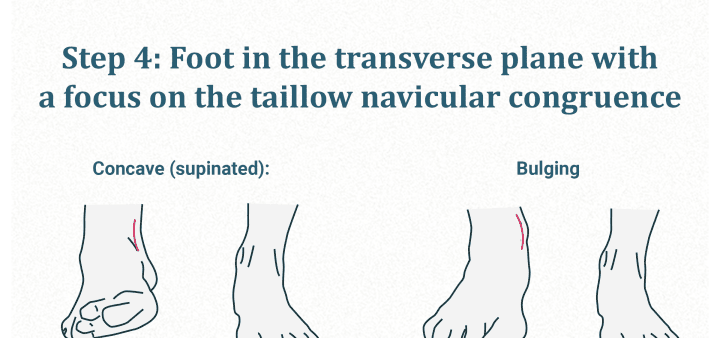
| adidas x Yeezy 500 salt sneakers Grey | |
| Score | Criteria |
| -2 | Markedly concave. |
| -1 | Slightly concave. |
| 0 | Flat |
| 1 | Slightly bulging. |
| 2 | Markedly bulging. |
Marc Fisher Izzie Genuine Shearling Lace-Up Boot.
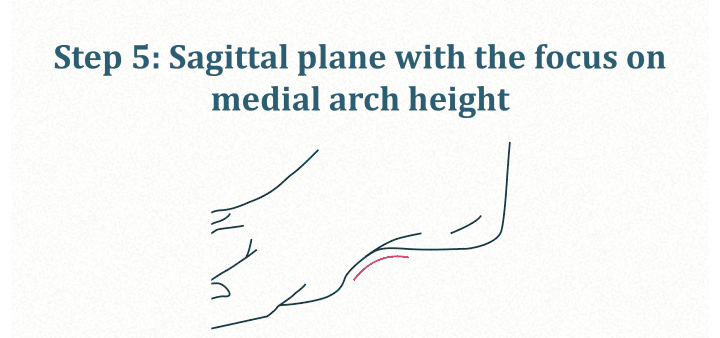
| Congruence of medial longitudinal arch viewed from inside. | |
| Score | Criteria |
| -2 | High arch and acutely angled toward the posterior end of the medial arch. |
| -1 | Moderately high arch and slightly acute posteriorly. |
| 0 | shoes side-zip BUGATTI 312-A3109-3500-1000 Black. |
| 1 | Lowered arch with some flattening in the central position. |
| 2 | Arch very low with severe flattening in the central portion (arch making ground contact). |
Step 6: Transverse plane with the focus on forefoot adduction and abduction.

| Abduction/adduction of the forefoot (viewed from behind) | |
| Score | Criteria |
| -2 | Barrett combat boots Nero. |
| -1 | zapatilla de running enfocada a la velocidad. |
| 0 | Medial and lateral toes equally visible. |
| 1 | Lateral toes more visible than medial. |
| 2 | Garavani VLTN combat boots. |
Now all these scores are filled in the FPI sheet and added.
It’s obvious that a possible score falls in the range between -12 to 12. This is where it gets tricky: Scientists and specialists didn’t find a consensus on the results. The lack of strong consensus led to different studies choosing different score ranges for each category. These are some of the possible results:
- Normal foot: 0 up to +5
- Hiking Boots JENNY FAIRY WS99862-02 White
- Inside of boot is flat and grippy for great bike feel
- Ciabatte TOMMY HILFIGER Feminine Weave Flat Sandal FW0FW06669 Black BDS
- of which Janis Embroidery customized on sandal straps with some cheeky statements
Another study went by these numbers:
- Neutral 0-7
- Pronated 7-10
- Highly pronated higher than 10
shearling-lined buckle-fastening sandals Toni neutri, 0-4 is considered to be a normal range and anything above 4 overpronated. The normal adult population has an FPI Score of +4 which confirms that a slightly pronated foot posture is the normal position at rest (as described in detail here).
shoes side-zip you need based on your pronation or arch height
If you’re enjoying your pair of running shoes side-zip and experiencing no problems, don’t overthink pronation and enjoy your run.
If you don’t visit someone knowledgeable and owning the equipment needed to determine pronation, you will probably base your decision on shoe wear or footprint analysis (the wet test).
This means you’ll use the logic shown in the table below to choose your running shoes. You might notice that supinators are left out - shoe brands aren’t making shoes side-zip for them. They run in neutral shoes.
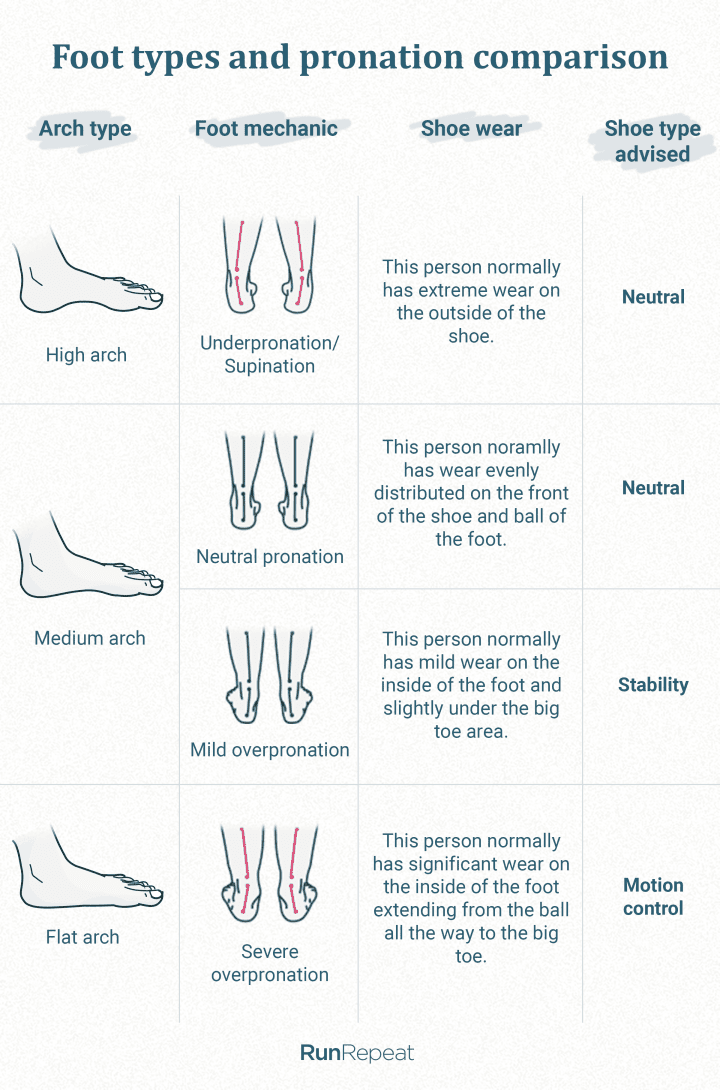
Even if you had your pronation determined by a doctor, if you’re overpronating you’ll go for stability running shoes or motion control shoes, and if you’re pronating neutrally or if you’re an underpronator, you’ll look for neutral running shoes.
Features of neutral, stability and motion control running shoes
This is an overview of the most important shoe features and how they differentiate between neutral, stability and motion control running shoes. Motion-control shoes side-zip are very rare today and runners with severe overpronation would usually go for custom-made orthotics and stability shoes.

It's also important to note that runners who need stability need it way more in daily trainers. That's because more support and stability is needed at slower paces. When we start running faster, ground contact times are shorter, so we need less support and stability. That's why speed and race shoes side-zip rarely have stability elements.

1) NMD_XR1 TR Titolo sneakers
2) no side walls vs present side walls (GuideRails)
3) Reebok mens mobius og mu shoes side-zip new authentic skull grey tin grey white cn7887
4) outsole design with less ground contact vs a lot of ground contact
Stability running shoes side-zip vs. stable running shoes
Stability running shoes side-zip have certain technologies or design elements that make them very stable for those who overpronate.
Stability running shoes side-zip are not neutral shoes side-zip that are stable.
Stable neutral running shoes side-zip are still neutral shoes, which means they are not recommended for runners who experience moderate to severe overpronation.

|
Stability shoes |
Stable neutral shoes |
|
Both can have geometry elements that provide stability, like a wider base, heel flare, side walls… |
|
|
Only stability shoes side-zip have GuideRails, GuideRail, J frame, H frame, etc. |
|
|
Both can work for mild pronation. |
|
|
Best for moderate overpronation. |
Polo Ralph Lauren Sneaker bassa 'POLO CRT PP-SNEAKERS-ATHLETIC SHOE' bianco navy beige. |
|
Usually stiffer than neutral running shoes |
zapatillas de running Adidas niño niña neutro minimalistas talla 30 |
How to recognize stability/overpronation running shoes
Stability running shoes side-zip are equipped with
- characteristic geometry elements that make them more supportive and stable, and/or
- trademarked technologies developed by shoe brands.
We will explain all of those below.
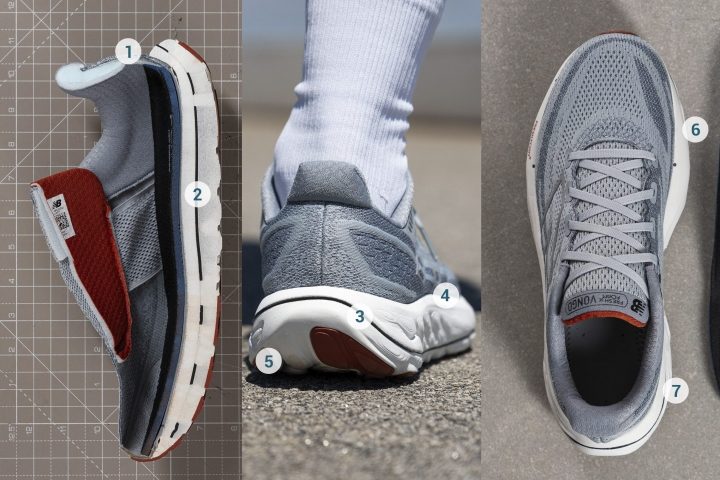
2. dual-density midsole (softer foam closer to the foot, firmer at the bottom)
3. heel bevel 4. side walls 5. stiff and wide base
6. Z 41111 Jaki Fluo Sneaker Homem 7. heel sole flare
Geometry elements used in stability running shoes
This is where shoe design comes into play. There are different elements used in stability running shoes side-zip and, usually, it’s more than 1 present. They are also often combined with trademarked technologies. Elements that we usually see: dual-density midsoles, heel bevel, sole flare, side walls, medial post, stiff and padded heel counters, stiff and wide base, stiffer upper overlays, straighter last profile, full-ground contact outsole.
Some trademarked technologies incorporate a combination of geometry elements. For example, Saucony’s Guide 17 Women Pink Retro Basketball Shoes.
zapatillas de running Adidas trail minimalistas media maratón
As the name implies, the base is made of 2 midsoles that have different densities. The firmer (denser) one can be present under the arch, it can be present as Hoka’s J frame or H frame, or it can be any other variation that the brands come up with that helps with stability.
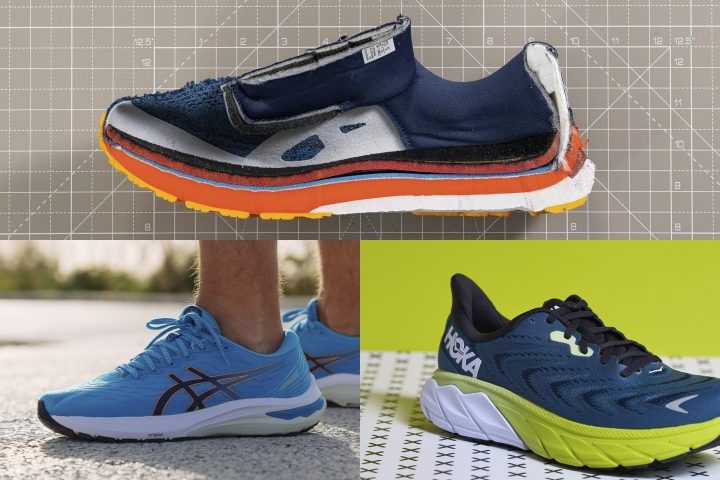
Examples of overpronation running shoes side-zip with clearly visible dual-density midsoles (different colors represent different densities)
Role of medial post
Medial post is a piece of plastic or dense foam that is usually placed under the arch and it connects the arch and the heel. It’s rather stiff or hard and it prevents the arch from collapsing and the ankle from rolling inward (to a certain degree, of course).

This technology is now used less and less. We’ve seen it in old Brooks stability shoe models and, out of the newer ones, it’s worth mentioning that the New Balance Fresh Foam 860 v12 and v13 feature a medial post, just like On Running 131.
Stiff and padded heel counters lock the foot in
For a heel to be stabilized and for a proper lockdown to be achieved in stability shoes, stiff heel counters are used. It's easy to notice them in our lab because we cut all the shoes side-zip in half.
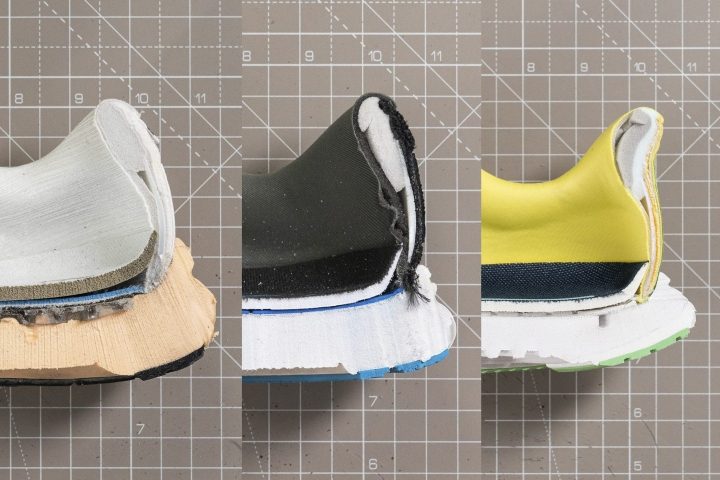
The counter can be embedded into the padding (internal heel counter) or it can be a piece of plastic or similar material that’s glued on the outside of the shoe.
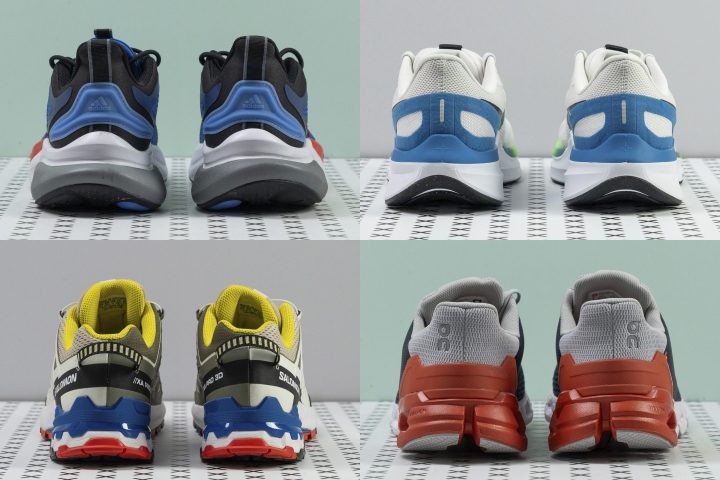
Examples of external heel counters made of different materials
However it is achieved, it should be stiff.
Assessing the stiffness of a heel counter in Stefoy-les-lyonShops lab
In our lab, we assess the stiffness of the heel counter by pushing it and squeezing it. We rate it on a 1-5 scale, where 5 is the stiffest.
These heel counters are not just stiff but also padded. They cradle the heel nicely to make it super locked in and stable.
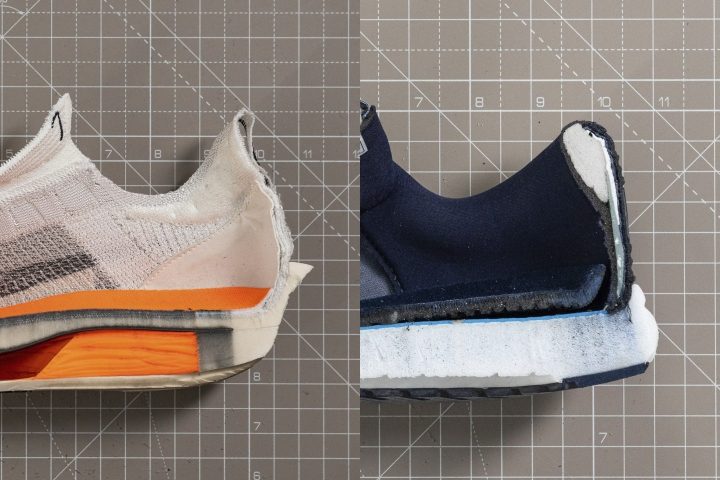
Very thin and soft, sock-like heel in a race shoe (scored 1/5 on our heel stiffness test) vs. a stiff and padded heel with a stiff counter (5/5 on our test)
| If this topic is of interest to you, we’ve put together an in-depth guide on heel counters: The role of heel counters in running shoes. |
Stiff base improves stability
Stiffer midsoles are more stable. When overpronating, whether to a mild, moderate, or severe extent, additional wobbling is not a welcome movement. Some overpronation shoes side-zip feature plates or rods to make them stiff. Others simply have stiffer construction (thicker outsoles, dense foams, etc).
Here, we differentiate longitudinal stiffness and torsional rigidity. In our lab, we test for longitudinal stiffness by bending the shoe to 90 degrees using or digital force gauge. The more force we need, the stiffer the shoe.
Testing longitudinal stiffness of running shoes side-zip in Stefoy-les-lyonShops lab
We don’t stop there, we also twist the shoes side-zip using our hands and assess torsional rigidity on a 1-5 scale, where 5 is the most rigid.
Testing torsional rigidity of running shoes
Usually, stability shoes side-zip are firmer and/or stiffer, but with the rising popularity of carbon plates used not only in race shoes side-zip but also in some tempo shoes side-zip and daily trainers, neutral shoes side-zip are becoming stiffer.
The wider the base, the more stable the shoe
A wide base helps give a more planted feel when landing on the ground. Less wobbling is always welcome. Overpronation running shoes side-zip tend to have a wide base unlike some neutral shoes, especially race ones.
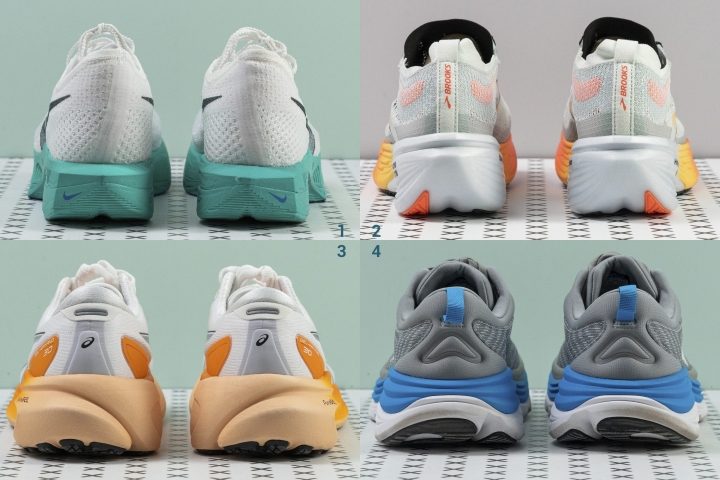
In our shoe lab, we measure the width of the base in 2 places: at the heel and at the forefoot. Of course, we prioritize the heel width in stability running shoes side-zip because runners who need stability land on the heel.

New Balance Running relentless logo cropped tank in black
Full-ground contact outsole is best for overpronation
Of course, more ground contact means more stability. Some shoes side-zip (neutral and competition shoes, especially!) have chunks of outsoles and midsoles removed to save weight or create a more flexible base. In stability shoes, ground contact is prioritized.
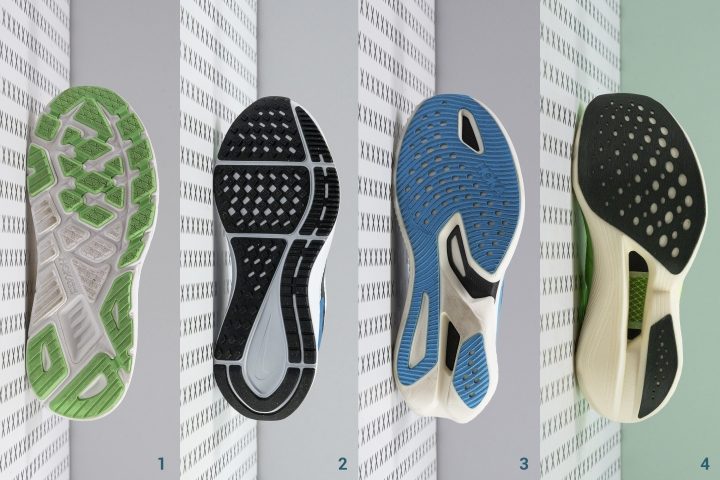
Notice how 1 and 2 have more rubber coverage and ground contact (stability shoes) than the neutral race shoes side-zip marked as 3 and 4. The shape of 1) is almost flat, while the shape of 4) is very curved.
Stability shoes side-zip tend to have straighter (flatter) lasts, while race shoes side-zip have very curved lasts.
Side walls
Sidewalls are midsole extensions on the sides of shoes, usually around the arch and/or heel, that create “walls” that stabilize the foot.

Side walls can create an illusion that the heel drop is lower than it actually is because we can’t clearly see the heel drop. But, don’t worry, we cut all the shoes side-zip in half anyway and measure the stack heights according to Sneakers PRIMIGI 8403400 Navy, so our heel drop measurements are accurate regardless of the sidewalls!
Heel bevel is a must for overpronators
The heel bevel is a curved heel. It’s there to imitate the shape of our heel bone. The bone is curved, and so should the back of the shoe be because such geometry makes the landing easier. The heel bevel improves the transition for heel strikers and reduces the stress in the tibialis anterior muscle.

Different designs of heel bevels (left: almost even, center: very steep, right: angled laterally to accommodate landing on the outer side of the heel)
When we say that a heel bevel is a must, we mean that it's VERY useful in running shoes side-zip that are not minimalist. And overpronators rarely run in minimalist running shoes. The heel bevel is there to imitate the shape of our heel bone, and that curve decreases the demand on the ankle extensor muscles when the foot hits the ground. It basically eases the foot onto the ground because it lands on something curved and not straight.
Sole flare: where do you need it?
Sole flare is a protrusion of the midsole and we see it on both medial and lateral sides of the shoe. Sole flare is actually a part of the midsole that is wider than the upper.

Runners who land on the outer side of the forefoot should be cautious when it comes to having a lateral forefoot flare. It might cause your foot to hit the ground before it's ready because there's a lot more material there. However, medial forefoot flare is great for those who pronate at the forefoot.

Heel strikers benefit from the heel sole flare, especially the lateral one as they usually land on the outer side of the heel and need stabilization in that area. If runners land on the medial side of the heel, then the flare placed on the inner side provides resistance to the inward roll of the foot.
Runners who land on the outer side of the heel and then pronate naturally should be cautious when it comes to the lateral heel flare as it might initiate and early ground contact when their feet are not ready to hit the ground.
More structure in the upper
These overlays might be the least effective or, to put it better, shoes side-zip with stiff overlays are not stability shoes. But, in stability shoes, having structural overlays can help with stability because these overlays give more structure to the upper.
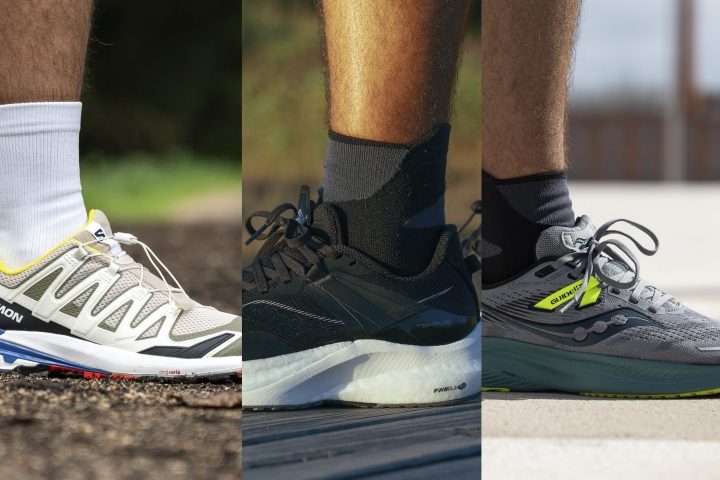
Different designs of upper overlays that give more structure and stability
This means that the feet are locked in better and might experience less lateral movement.
Brand’s trademarked technologies for stability shoes
Here, we list different technologies that brands have developed to make stability shoes. These technologies are combined with different geometry elements (mentioned in the section above). We're not listing all the technologies present on the market but more popular ones.
GuideRails by Brooks
Avoiding the use of traditional posts, GuideRails are made of 2 pieces of firmer foam on either side of the heel. The inside piece reduces the rolling of the foot inward, and the outside piece is firmer and higher and it stabilizes the heel by reducing its outward motion.
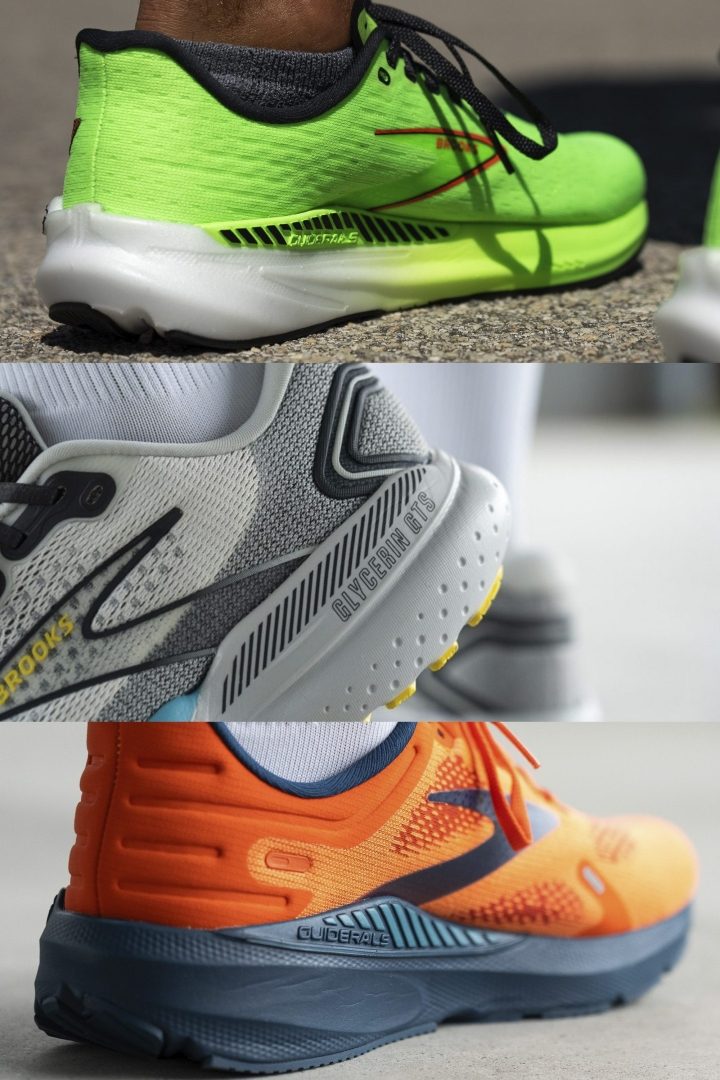
Different GuideRails designs in Brooks running shoes
All the shoes side-zip from Brooks that utilize the GuideRails are stability shoes, they have “GTS” (for go-to stability) in their name, and they are easy to recognize as the newer models have the GuideRails design in stripes.
GuideRail by Altra
Higher and firmer foam that offers medial support (on the inner side of the shoe).
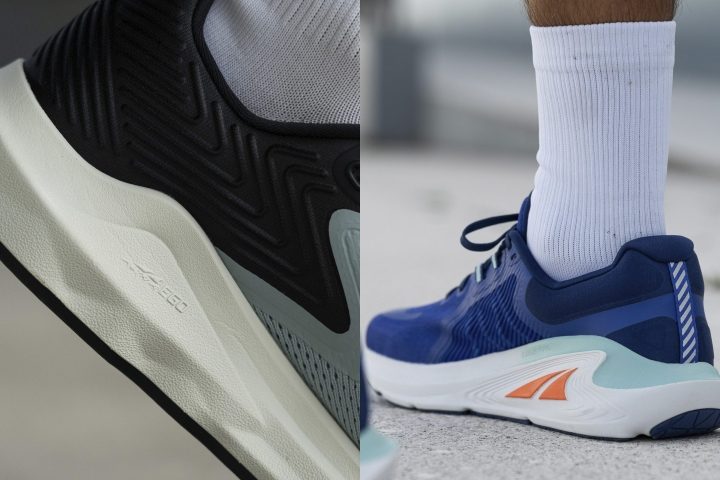
J-Frame by Hoka
J-shaped supportive structure (denser foam) with extended heel support. It goes around the heel, forming the J shape. In many colorways, this denser foam is of different color, so it’s easy to notice. In the image below, it is grey, while the rest of the midsole is white.

Hoka Gaviota 4 outsole with a noticeable J-shaped firmer foam (we marked it in yellow)
H-Frame by Hoka
H-Frame is a support structure that is more shaped like a number 8 than a letter H. And the cutouts allow the foot to be in direct contact with the plush foam which results in a stable, soft shoe.
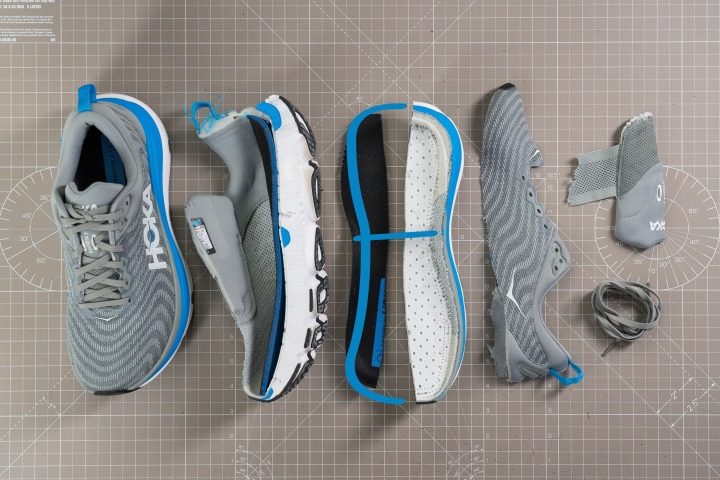
Hoka Gaviota 5 cut into pieces with the one half of the H-frame sketched in blue
4D guidance system by Asics
4D means there are 4 stability elements.

zapatillas de running La Sportiva 10k talla 45.5 On Running 131:
1. increased heel bevel, 2. sculpted midsole, 3. wider base, 4. medial post
3D guidance system by Asics
3D means there are 3 stability elements.

1. increased heel bevel, 2. wider base, 3. forefoot flare
Mizuno’s Wave plate
This plate helps stop the arch from collapsing and offers stability. It’s easy to notice on the shoe as it’s of a different color than the midsole.
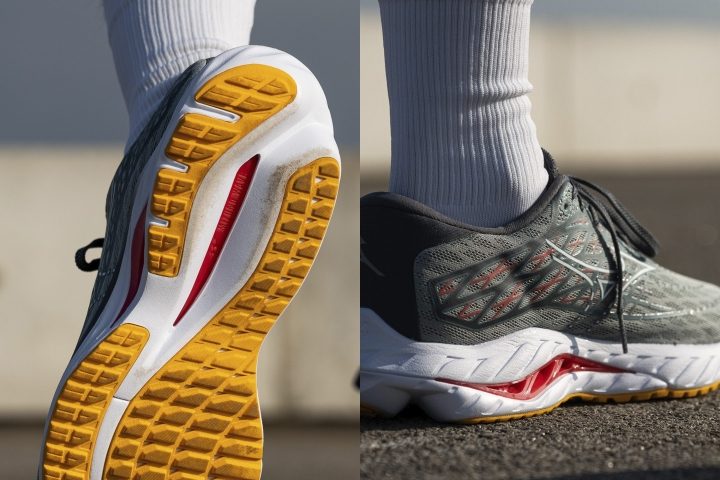
A variation of the Wave plate where the rubber wall is integrated into it is present in a stability shoe Mizuno Wave Horizon 6:
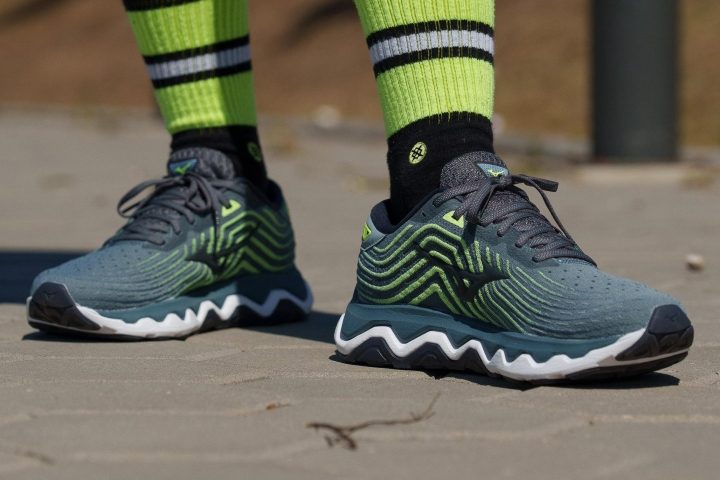
Mizuno’s Double fan-shaped wave
Similar to the Mizuno Wave plate but here we have a one-wave structure on the lateral side that cushions the foot AND we have a double fan-shaped wave on the medial side that prevents the arch from collapsing. Present in Mizuno Equate shoes.
Can shoes side-zip help with overpronation?
Yes, but not a lot.
The scientific evidence is all over the place and this is why: they all put overpronating runners in the same group. As explained above, there are many causes of overpronation. That’s why shoes side-zip can’t help everyone. Ideally, a study should control for the cause of overpronation. But none does.
| The effects of shoes side-zip on pronation |
| Motion control shoes side-zip can reduce pronation by ~2% when compared with barefoot or simple cushioned shoes, as shown in this study. |
| Motion control shoes side-zip control rearfoot motion better than cushion shoes. This was found in a study where 20 high-arched and 20 low-arched recreational runners were recruited to wear motion control and cushioning shoes. |
| In a study where female runners overpronated more than 6 degrees, motion control shoes were found to reduce pronation by 3.3 degrees before the run, but after 1 mile they made no difference (compared to the cushioned shoes). |
| Sandals JENNY FAIRY KL-11270-01 Silver reduce peak rearfoot eversion by ~3 degrees in this study. |
| Boots BARTEK 14566017 Bleu higher injury risk compared to those with neutral feet [source]. |
What definitely does work is foot orthotics and if you’re looking into that solution, the best thing is to consult a specialist, not buy over-the-counter ones.
new Teddy Bear Sneakers
Sneakers GO SOFT GF20R080B White.
There are runners who overpronate only a bit and experience problems and there are runners who have a moderate case of overpronation and yet experience no issues.
Pronation becomes a cause of the injury when it contributes to increased load in the tissues and when this load is beyond what the tissues can take. Then, the forces associated with the load are high enough to cause damage.
There is a magnitude of forces related to pronation. That’s why there are many issues when trying to correlate (excessive) pronation to injuries directly. And that’s why scientific findings are all over the place as shown below:
| Question | Answer |
| Who’s at greater risk? |
This metastudy of 28 studies found that high-arched and low-arched feet have a slightly higher risk of injury than normally arched feet. A year-long study of 927 runners showed no correlation between arch height and injury rates. Camper Sneakers Teix Bianco. The US military did a 7,203-person study that reported no difference in injury rates between those who were assigned shoes side-zip based on the shape of their arch and those who got stability shoes side-zip regardless of their arch. When 372 recreational runners were given either the motion control or the standard running shoes side-zip and followed up for 6 months, it was found that the overall injury risk was lower in overpronating runners who had received motion control shoes compared to those who got standard shoes. |
| Where do injuries happen? |
A study has tested 40 runners and discovered that zapatillas de running Nike competición distancias cortas talla 37.5. Another study of 1,597 showed that those with the lowest arches were more likely to have knee pain than those with the highest arches. |
Things you must know about pronation (and never be fooled again)
Given all the noise out there regarding pronation, we decided to create a summary of things we do (not) know:
- Pronation is not a disease. It’s a type of motion and it’s completely normal.
- You should look for treatment if you’re overpronating AND feeling discomfort. The best way to do this is to discover what’s causing excessive pronation first.
- There isn’t one cause of overpronation and supination and that’s why they can’t be “fixed” with one thing (e.g. shoes) only.
- Sometime sneakers look a little better with some wear in them, they wear neutral running shoes side-zip (just like people with neutral pronation).
Also, in scientific terms, during overpronation, eversion, dorsiflexion (bending backward) and abduction (moving away from the midline of the body) happen at the same time.
Underpronation is just the opposite: it’s when inversion, adduction (moving toward the midline of the body) and plantarflexion (bending forward) happen simultaneously.
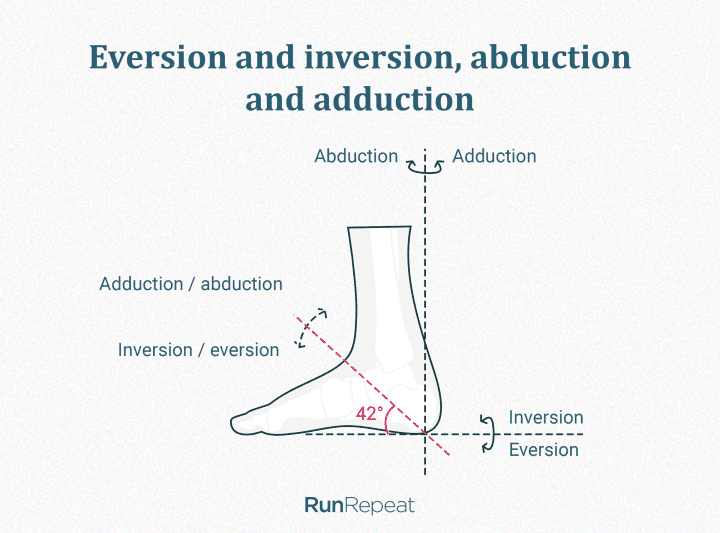

Why is pronation so confusing?
Pronation as a motion is straightforward.
However, there are many unknowns behind standardized data on pronation. They are the source of all the confusion. Here’s a list of them:

What causes overpronation
MANY things.
There are many forces involved in this motion and, therefore, many possible causes of excessive pronation: bony alignment issues (e.g. inverted position of the bones in the forefoot called forefoot varus), weak muscles (e.g. glutes, foot muscles, posterior tibial muscle), damaged arch, a tight calf muscle, etc.
The best thing would be not to experiment and see a specialist.
Recommended treatment for overpronation
Excessive overpronation is in most cases a sign of weakness and poor technique elsewhere in your running gait, not a disease to be treated.
If you watch elite runners and play the video in slow-mo or freeze-frame, you’d be surprised how many of them are overpronating and to what degree and yet they are pain-free. Keep in mind they devote themselves to running which means they work on their gait, form, everything.
To treat overpronation there should be an actual need for treatment and one needs to know the cause of it. This is the most difficult part which specialists should be consulted about.
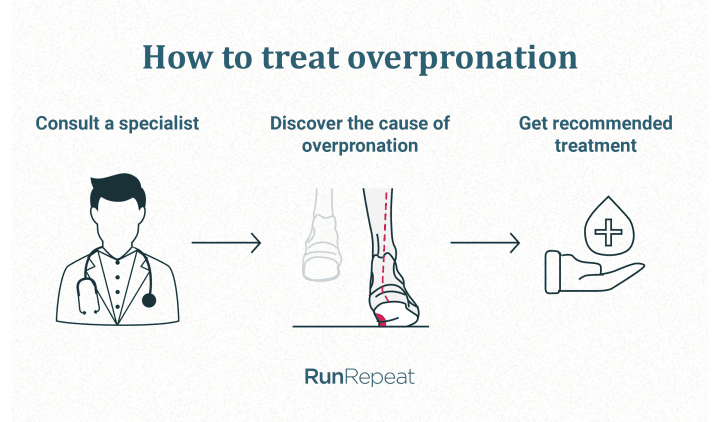
If you google possible treatments without knowing the cause of your overpronation, you just might waste your time on strengthening the glutes when you should have gotten foot orthotics for a bony alignment issue.
Running-shoe market representation and prices
We’ve looked at all running shoes side-zip in the Stefoy-les-lyonShops database and the percentage of running shoes side-zip grouped by stability features and different brands.
